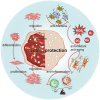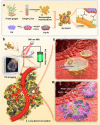Plant-derived nanovesicles: harnessing nature's power for tissue protection and repair
- PMID: 38001440
- PMCID: PMC10668476
- DOI: 10.1186/s12951-023-02193-7
Plant-derived nanovesicles: harnessing nature's power for tissue protection and repair
Abstract
Tissue damage and aging lead to dysfunction, disfigurement, and trauma, posing significant global challenges. Creating a regenerative microenvironment to resist external stimuli and induce stem cell differentiation is essential. Plant-derived nanovesicles (PDNVs) are naturally bioactive lipid bilayer nanovesicles that contain proteins, lipids, ribonucleic acid, and metabolites. They have shown potential in promoting cell growth, migration, and differentiation into various types of tissues. With immunomodulatory, microbiota regulatory, antioxidant, and anti-aging bioactivities, PDNVs are valuable in resisting external stimuli and facilitating tissue repair. The unique structure of PDNVs provides an optimal platform for drug encapsulation, and surface modifications enhance their stability and specificity. Moreover, by employing synergistic administration strategies, PDNVs can maximize their therapeutic potential. This review summarized the progress and prospects of PDNVs as regenerative tools, provided insights into their selection for repair activities based on existing studies, considered the key challenge for clinical application, and anticipated their continued prominent role in the field of biomedicine.
© 2023. The Author(s).
Conflict of interest statement
The authors declare that they have no competing interests.
Figures





Similar articles
-
Exploring new avenues of health protection: plant-derived nanovesicles reshape microbial communities.J Nanobiotechnology. 2024 May 19;22(1):269. doi: 10.1186/s12951-024-02500-w. J Nanobiotechnology. 2024. PMID: 38764018 Free PMC article. Review.
-
Plant-Derived Nanovesicles: A Promising Frontier in Tissue Repair and Antiaging.J Agric Food Chem. 2025 Jun 4;73(22):13159-13177. doi: 10.1021/acs.jafc.5c01547. Epub 2025 May 22. J Agric Food Chem. 2025. PMID: 40402864 Free PMC article. Review.
-
Plant-derived nanovesicles and therapeutic application.Pharmacol Ther. 2025 May;269:108832. doi: 10.1016/j.pharmthera.2025.108832. Epub 2025 Feb 27. Pharmacol Ther. 2025. PMID: 40023319 Review.
-
Engineered Plant-Derived Nanovesicles Facilitate Tumor Therapy: Natural Bioactivity Plus Drug Controlled Release Platform.Int J Nanomedicine. 2023 Aug 22;18:4779-4804. doi: 10.2147/IJN.S413831. eCollection 2023. Int J Nanomedicine. 2023. PMID: 37635909 Free PMC article. Review.
-
Biological properties and therapeutic effects of plant-derived nanovesicles.Open Med (Wars). 2020 Nov 9;15(1):1096-1122. doi: 10.1515/med-2020-0160. eCollection 2020. Open Med (Wars). 2020. PMID: 33336066 Free PMC article.
Cited by
-
Targeting cGAS-STING pathway for reprogramming tumor-associated macrophages to enhance anti-tumor immunotherapy.Biomark Res. 2025 Mar 12;13(1):43. doi: 10.1186/s40364-025-00750-w. Biomark Res. 2025. PMID: 40075527 Free PMC article. Review.
-
Lavender Exosome-Like nanoparticles attenuate UVB-Induced Photoaging via miR166-Mediated inflammation and collagen regulation.Sci Rep. 2025 Jul 1;15(1):21286. doi: 10.1038/s41598-025-08817-2. Sci Rep. 2025. PMID: 40596624 Free PMC article.
-
Exploring the bioactivity of MicroRNAs Originated from Plant-derived Exosome-like Nanoparticles (PELNs): current perspectives.J Nanobiotechnology. 2025 Aug 12;23(1):563. doi: 10.1186/s12951-025-03602-9. J Nanobiotechnology. 2025. PMID: 40796868 Free PMC article. Review.
-
Comparison of nanovesicles derived from Panax notoginseng at different size: physical properties, composition, and bioactivity.Front Pharmacol. 2024 Jul 22;15:1423115. doi: 10.3389/fphar.2024.1423115. eCollection 2024. Front Pharmacol. 2024. PMID: 39104384 Free PMC article.
-
Plant and animal-derived fusion nanovesicles rescue inflammation-compromised osteogenic potential of periodontal ligament stem cells.Front Cell Dev Biol. 2025 Feb 27;13:1512238. doi: 10.3389/fcell.2025.1512238. eCollection 2025. Front Cell Dev Biol. 2025. PMID: 40083664 Free PMC article.
References
Publication types
MeSH terms
Substances
Grants and funding
LinkOut - more resources
Full Text Sources

